
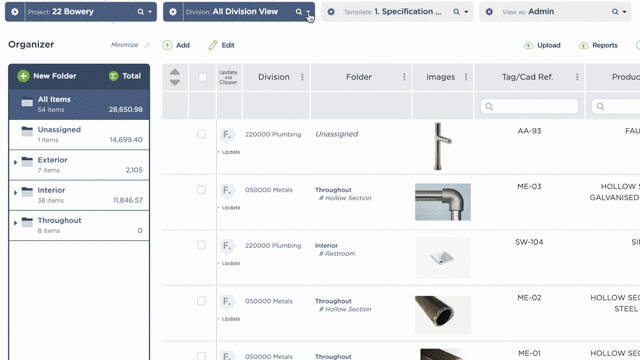
Manage FF&E specification, procurement, and product data at scale. Take on bigger projects with confidence and grow your firm with Fohlio. Book a consultation with one of our account managers to explore these features today.
FF&E specification has a reputation for being tedious. But add to that the effort of trying to stay within budget, managing bids, wrangling spec sheets, and repetitive work — and the entire process could get positively glacial.
That’s why we created several functions in Fohlio that not only help you save money, but also time.
— Sign up for a Fohlio demo here. —
We know you’re already more than familiar with most of the common cost management methodologies, so we’re going to show you how to make those processes much more efficient.
1. Set an FF&E Budget — But Know Where You Have Flexibility
When you know where every dollar of your budget is going to be spent, it’s much easier to figure out where you can scrimp, and where you can splurge.
What you can do is familiarize yourself with all the ways you can slice and dice your FF&E costs. You can do this with filters.
Every single product you specify has several different data points by which they can be categorized. You have your areas, of course. And then you can also segregate them according to CSI divisions, suppliers, and more.
Use different combinations of filters to answer questions regarding costs. For example: What’s the cost of FF&E for a king room? Does it make sense to splurge on a nice lounge chair in order to increase value and guest satisfaction?
Learn more: How FF&E is Bringing Hospitality Design Trends to Life
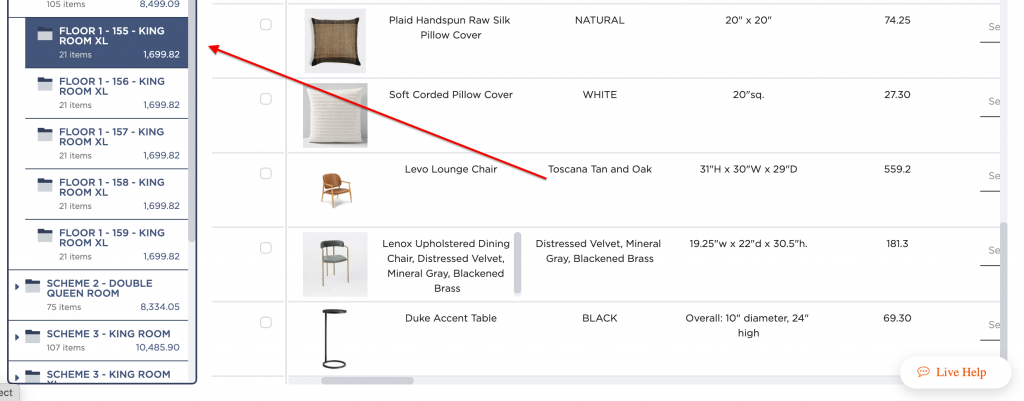
What’s the cost for all the throw pillows you’ll be ordering from Vendor A? Can you leverage this to get a discount?
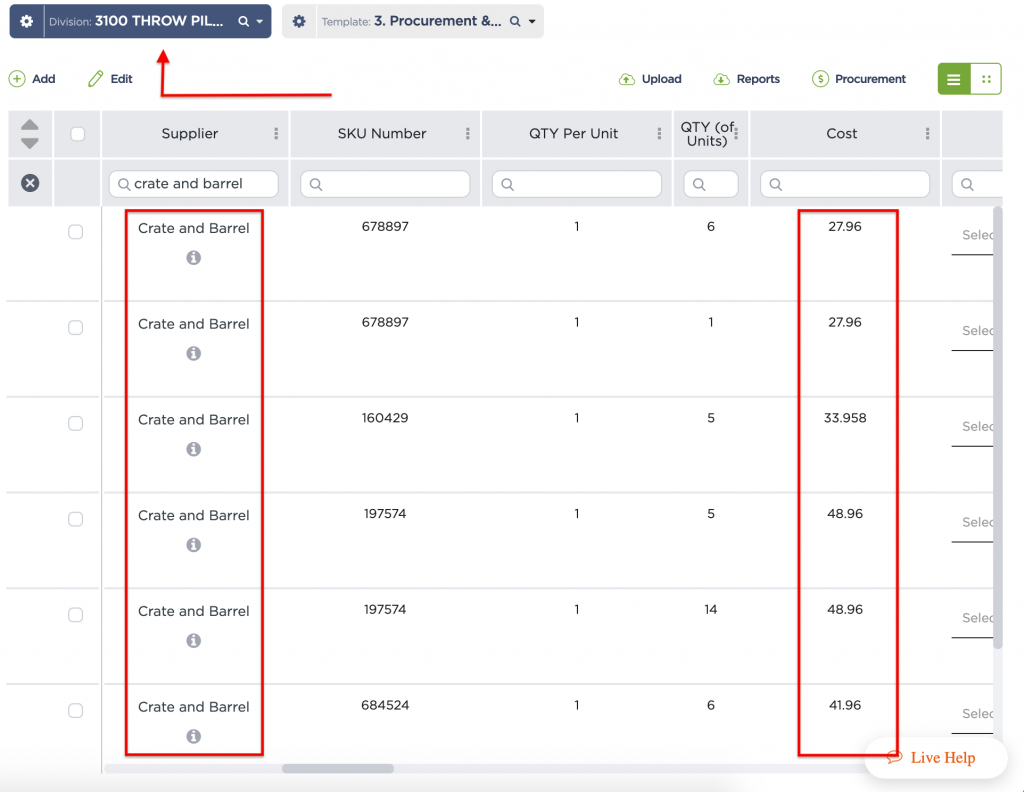 Filter your FF&E products by CSI division and supplier to get the total.
Filter your FF&E products by CSI division and supplier to get the total.
2. FF&E Procurement: Make Bidding More Bearable
The genius of the free market is how well it lends itself to competition. And isn’t the process of bidding out products and services a beautiful thing?
In theory, sure.
Thing is, bidding is a notoriously scattered process. Corralling all the price points, discount schemes, and payment terms takes days. Comparing them … makes no sense. Is this the price per piece? What’s this giant number at the bottom of the document? Does that include shipping and discounts?

What do you do? You enforce standards. Use a bidding platform that will compel your vendors to input the same information in the same places.
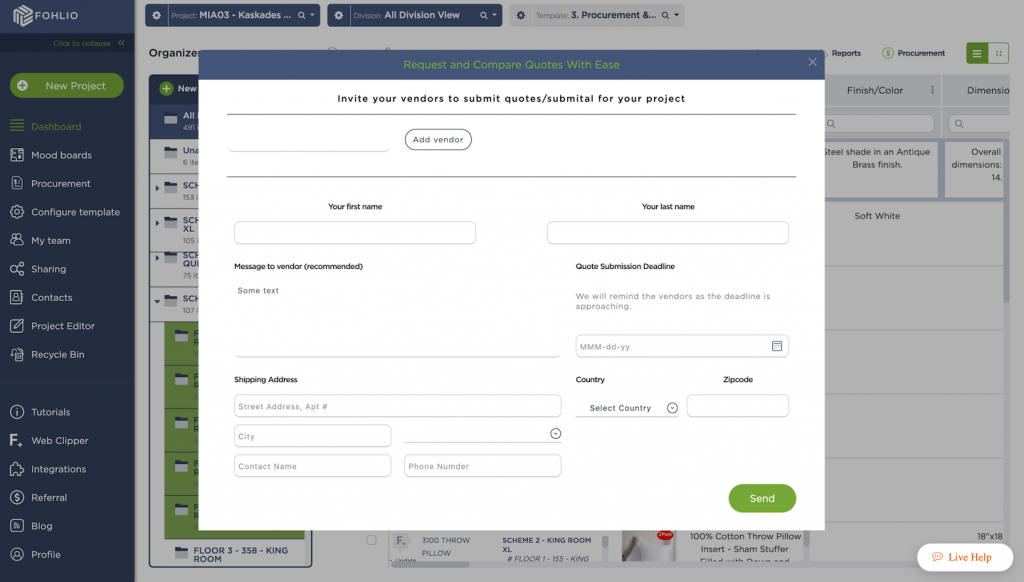
This way, you’re not wasting time while trying to save a few bucks here and there.
3. Generate Differentiation Documents — And Not From Scratch
After the bidding process comes the part where you keep track of which supplier is taking care of which product/s. Using a differentiation document ensures that no items are either left off or being supplied by two firms at once.
You can easily create reports with this information using the data you already have.
First, make sure that each separate item is assigned a unique tag. This can be their model number, stock keeping unit, or a reference number internal to your firm. The same faucet in three different finishes should be treated as three separate items.
Next, you need to create two separate documents: a list of all your products that shows which suppliers are handling them, and a list of your suppliers that shows which products they’re handling.

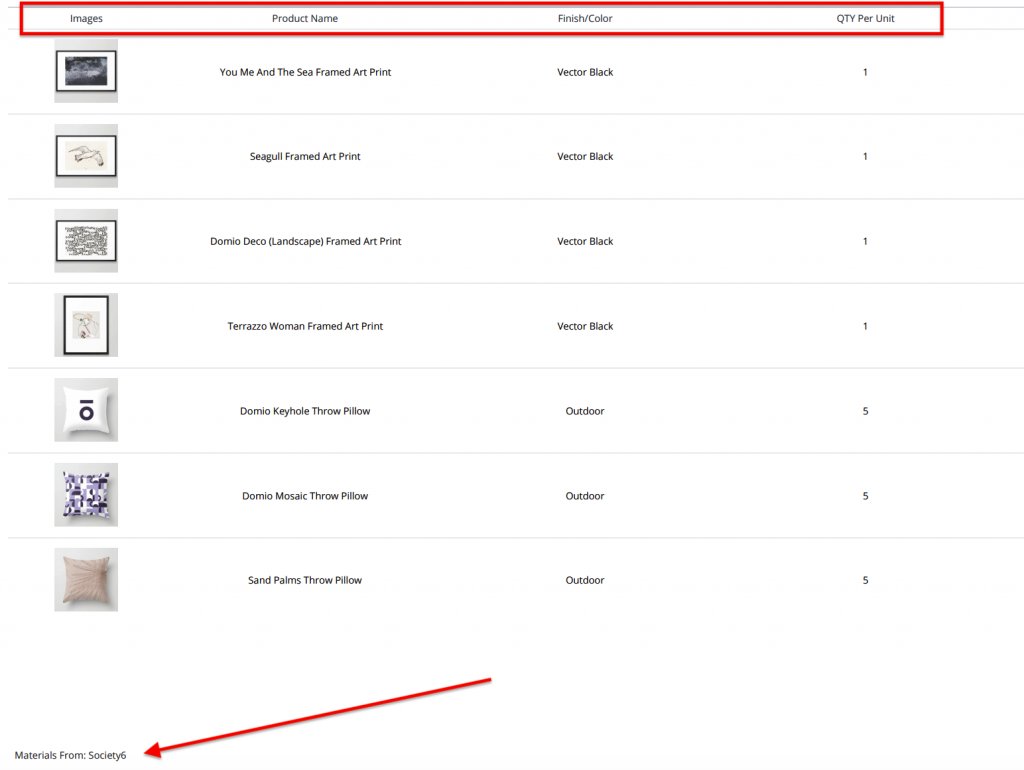
These are your basic differentiation documents, but you can also arrange data in ways that suit your specific needs.
4. The Template is Your Best Friend
If you want to break a future interior designer’s spirit, let them in on a little secret: A huge chunk of the process is actually made up of tedious and repetitive, but nonetheless necessary tasks.
The good news is that it doesn’t have to be nearly as awful as all that.
Templates are a powerful tool for saving yourself hours upon hours of mind-numbing and error-prone work. Here are a couple of ways to incorporate them in the FF&E specification process:
1. Room templates – Hospitality projects mean designing several different rooms. However, it’s important to remember that no matter what type, each room will start with several of the same basics: a bed, flooring, a desk, seating, lighting, a shower head, a faucet, etc.
Learn more: How to Build FF&E Brand Standards: An In-Depth Guide

Put together your basic punch list — and from there, create a duplicate and make variations as necessary.2. Workflow templates – Having all your data in one place is one half of the efficiency equation: It helps you get overall visibility into the different operations that affect yours.
The other half? That’s the ability to have everyone effectively utilize that data.
The problem with having lots of information is that it’s too easy to have too much. It’s hard to focus — and because of that, you end up taking longer than you should on whatever you’re working on. Which, of course, defeats the purpose of having all your data in one place.
Create separate workflow templates that help you (or your teammates) focus on different types of work.
For example, a spec sheet template or spec writing template will need columns for images, descriptions, spec types, and dimensions.
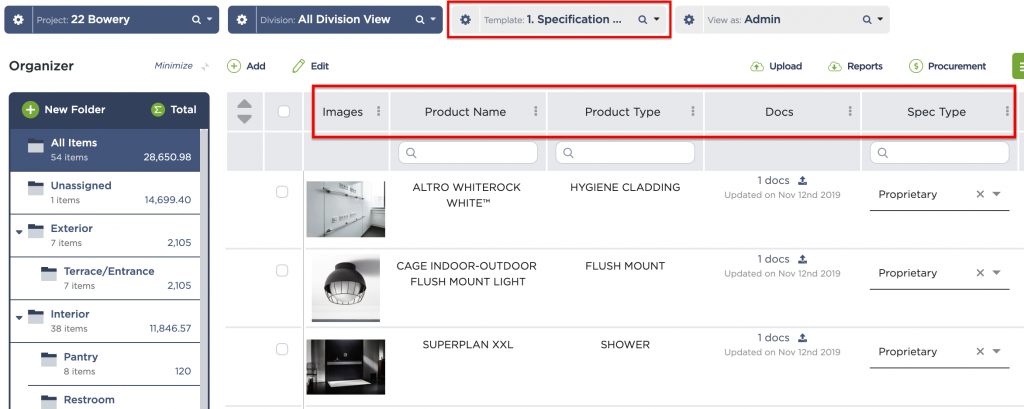
On the other hand, a procurement template will need columns for pricing, suppliers, expected delivery dates, and more.
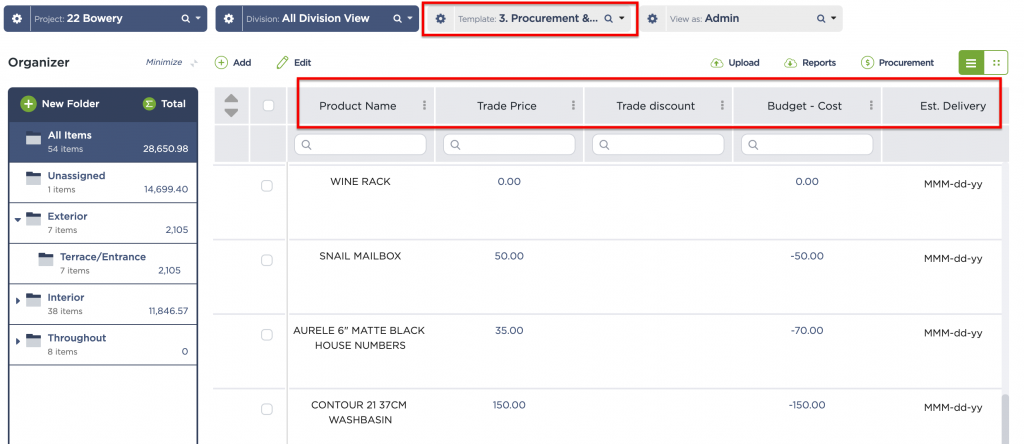
5. Create Model Rooms
There’s nothing quite like seeing actual products in action. Besides, it’s extremely satisfying and motivating seeing your design come to life without having to wait for several months.
Set up a model room for each type of room your hospitality project is offering and invite suppliers to send one-off samples. Do keep in mind that the cost for this has nothing to do with what you’re actually going to spend.
Seeing the products in a full scale setting helps you weigh their merits versus their production run cost in a more substantial manner. You might think that Desk A looks nicer than Desk B, and therefore worth the higher price. Or you might think that Desk B is more than adequate and a good value to boot.
6. Reduce Duplicate Work and Errors: Create Purchase Orders From Existing Spec Sheets
Procurement teams spend hours taking spec sheets from designers, re-typing them into ERP systems, and then checking and re-checking between the two databases to make sure everything is accurate and up-to-date.
Ideally, you want a system that allows your procurement team to work off of and build on existing data — that is, create POs straight from spec sheets:
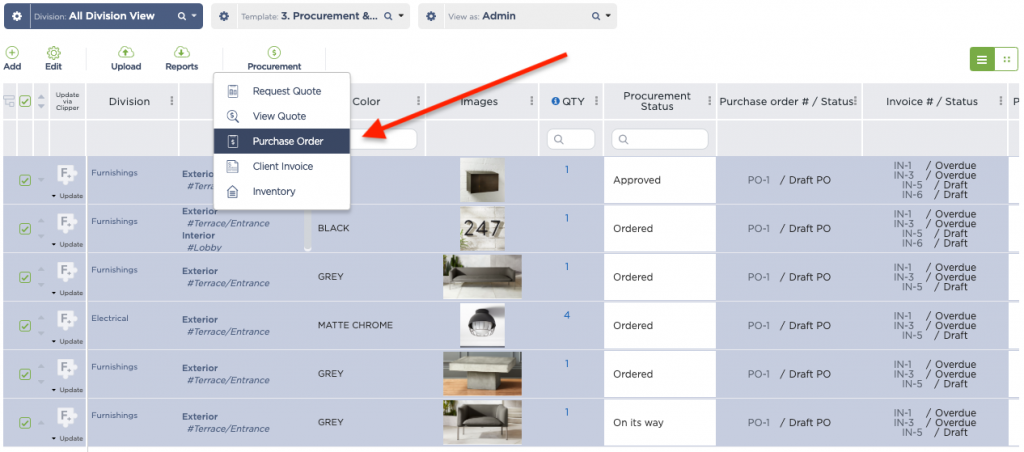
Furthermore, all this information should be stored in a centralized database so the entire firm can refer to it and learn from it anytime.
7. Use Procurement Software and Interior Design Software That Sync With Each Other
The typical scenario for procurement firms, or design firms with procurement teams, is that they utilize different tools to perform different tasks. Dropbox, for example, is a popular software for storing and sharing files.
Procurement teams will then have to duplicate and/or download the data they need, then enter it into a separate procurement software.
However, the procurement software doesn’t store information like product names and descriptions, so there’s a lot of repeated manual work.
In the meantime, there’s also a separate project management software for tracking data like shipment status, ship dates, notes, and more.
A centralized, collaborative platform allows your team members to drastically cut down on manual, repeated work, thus cutting down on work hours which can be spent elsewhere:

8. Improve Collaboration Throughout Your Design and Procurement Firm
Having a centralized digital materials library that everyone can access and work with is one of the best things you can do for your firm.
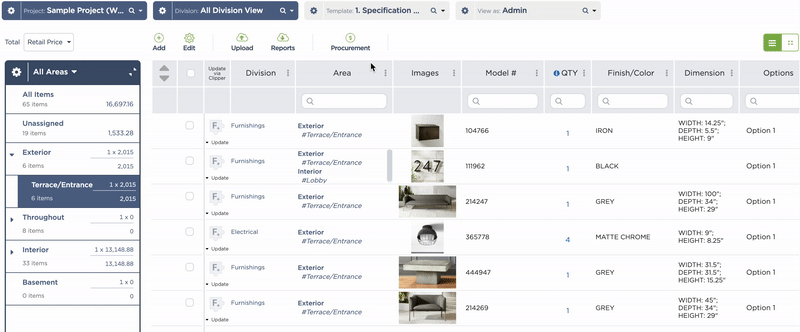
Re-specifying and re-ordering products from your trusted suppliers is more efficient when you don’t have to collect, copy, and paste the same data over and over.
If products are previously marked “discontinued” and categorized according to brand guidelines, you save your designers a lot of time during the FF&E specification or materials and finishes specification process.
Having a built-in mechanism for saving time (and therefore money) also allows you to focus on creating more value for your projects and clients. Of course, this goes a long way in ensuring satisfaction, client ROI, repeat business, and referrals.
9. Document FF&E and Materials Lifecycles With an Eye Towards Wealth Generation
Yes, documentation and data are important. Without them, it’ll be impossible to carry out such complex tasks as building, well, a building.
But consider this: The data you accumulate, if managed and organized well, can add so much more value. Someone who buys a building will want to know exactly what they’re getting. But the more they know — and the more easily the can access it — the better. For example: If the HVAC system suddenly malfunctions, you usually have to send somebody to look at serial numbers, call the manufacturer, and figure out the last time the equipment was serviced.
What if all they had to do was pull up a dashboard with all this information? In a few minutes, the maintenance team can find out whether the HVAC is still under warranty (or if they missed it by two days because it took that long to find the information).
It’s a small detail that makes a huge difference, it’s a value you can add to your service to help you stand out from the rest, and it’s an asset that owners will happily pay for.
10. Make Your Purchase Orders Do the Heavy Lifting in FF&E Procurement
In the past, purchase orders were just purchase orders: They documented the fact that you greenlit an expense.
Today, purchase orders can do so much more for your procurement and FF&E specification. For example: Your PO dashboard is where you can keep track of quantities and shipments. You can answer questions like, When are the tubs for the king suites supposed to arrive? Will they all get here in one delivery or more? How many have we received so far and how many more are coming?
POs also help forecast materials and FF&E funding needs. If you filter procurement documents by status, you’ll be able to see the amount of cash you’ll need for the next two months or so, depending on how your schedule funding tranches. This way, you can get approval ahead of time and be reasonably sure that your predictions are accurate.

11. Avoid Budget Creep
Costing inaccuracies are inevitable — you’re never going to cover everything 100%. The name of the game then becomes, keeping bloat as small as possible.
To do this, you need as much visibility into your project as possible. For example: identifying cost overruns upfront. Once you’ve set up a project budget in Fohlio, it’s kept front and center. That way, as you’re listing your products and getting an automatic tally, it’s also automatically being compared against your ceiling. If you go over the limit, there’s a visual reminder so you know where to cut it down way before you ever start spending.
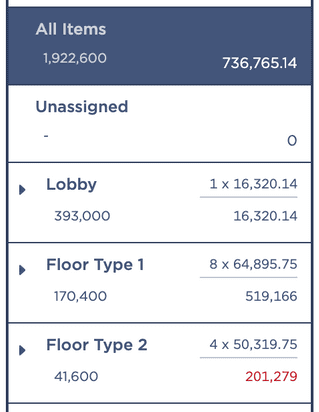
Learn more: 5 Ways to Avoid Budget Creep in Design and Construction Projects With Better Data Management
Fohlio helps you specify, procure, and manage FF&E materials data much faster and more efficiently than ever before. Get your trial today — so you can design and build more profitable projects.
Fohlio helps you specify, procure, and manage product data at scale. Take on bigger projects with confidence and grow your firm with Fohlio. Book a consultation today — so you can design and build more profitable projects.
Expore Fohlio
Learn how to:
- Save days of work with faster specification
- Create firm-wide design standards
- Automate and centralize procurement
- Keep your whole team on the same Page
- Manage product data
- Track budget against cost in real time.
- Prepare for asset valuation
Published Nov 17, 2019

